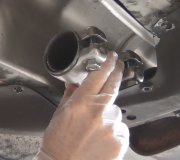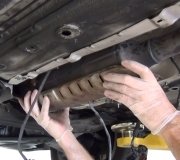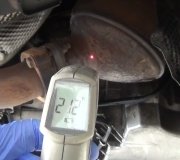Good afternoon.
Rings will never cause a crackle in your exhaust.
See if it has an air injection system that is run by an electric motor. The emission system sends additional air into the exhaust cold to help burn the un burned fuel coming out when cold.
That is a common issue.
Roy
Secondary Air Injection (AIR) System
Overview
The secondary AIR system controls emissions during the first few seconds of engine operation by forcing air downstream into the exhaust manifolds to oxidize the hydrocarbons and carbon monoxide created by running rich at start up.
Secondary AIR System
The secondary AIR system consists of an secondary AIR pump, check air injection diverter (AIR diverter) valve, an secondary AIR bypass solenoid, an AIR relay, a powertrain control module (PCM) and connecting wires, and vacuum hoses. For additional information on the secondary AIR system components, refer to Engine Control Components See: Computers and Control Systems > Diagnostic Trouble Code Tests and Associated Procedures > Engine Control Components.
1. The PCM requires engine coolant temperature (ECT) or cylinder head temperature (CHT), mass air flow/intake air temperature (MAF/IAT), and crankshaft position (CKP) sensor inputs to initiate the secondary air injection function.
2. When the engine is started, the strategy determines when to enable the secondary AIR pump. The PCM signals the AIR relay and the AIR bypass solenoid, after a 5 to 15 second delay, to begin system operation. Once the catalyst is lit-off, the PCM then signals the AIR relay to stop secondary AIR pump operation and to close the AIR bypass solenoid from supplying vacuum to the AIR diverter valve.
3. The AIR relay provides the start-up signal and switches the high current required to operate the secondary AIR pump.
4. The AIR bypass solenoid applies a vacuum to the AIR diverter valve(s) causing it to open and to allow air to flow into the exhaust manifolds.
5. The secondary AIR pump draws dry filtered air from the intake air system downstream of the MAF/IAT sensor.
6. The secondary AIR pump delivers the required amount of air to control emissions during engine operation. Air is forced into the exhaust manifolds to oxidize the hydrocarbons and carbon monoxide created by running rich at start up.
Friday, October 12th, 2018 AT 10:30 AM


